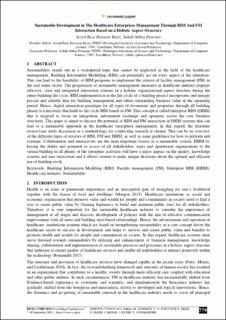| dc.contributor.author | Raviz, Seyed Reza Hosseini | |
| dc.contributor.author | Petersen, Sobah Abbas | |
| dc.date.accessioned | 2022-10-04T06:16:34Z | |
| dc.date.available | 2022-10-04T06:16:34Z | |
| dc.date.created | 2021-11-14T13:29:59Z | |
| dc.date.issued | 2021 | |
| dc.identifier.citation | Proceedings of International Conference on Urban Development, Regional Planning and Information Society. 2021, 779-788. | en_US |
| dc.identifier.issn | 2521-392X | |
| dc.identifier.uri | https://hdl.handle.net/11250/3023447 | |
| dc.description.abstract | Sustainability stands out as a widespread topic that cannot be neglected in the field of the healthcare management. Building Information Modelling (BIM) can potentially act on every aspect of the enterprise. This can lead to the feasibility of BIM programs to implement the criteria of facility management (FM) in the real estate sector. The progression of sustainable management measures in healthcare industry requires effective, clear and integrated interaction systems in a holistic organizational aspect structure during the entire building life cycle. BIM implementation in the life cycle of a building project incorporates and merges precise and reliable data for building management and offers outstanding business value in the operating period. Hence, digital interaction paradigm for all types of documents and properties through all building phases is a necessity that leads to life cycle BIM based on FM. This concept is called enterprise BIM (EBIM) that is targeted to focus on integration, information exchange and openness across the core business structures. This paper is aimed to discuss the potential of BIM and FM interaction in EBIM systems that can lead to a sustainable approach in the healthcare enterprises management. In this regard, the literature review/case study discussion as a methodology for conducting research is chosen. This can be an overview of the different types of reviews of BIM, FM and EBIM, as well as some guidelines for how to perform and evaluate. Collaboration and interactivity are the most important factors in a sustainable system. EBIM by having the ability and potential to access of all stakeholders, users and operational organizations to the virtual building in all phases of the enterprise activities will have a major impact on the quality, knowledge transfer and user interaction and it allows owners to make unique decisions about the optimal and efficient use of building stock. | en_US |
| dc.language.iso | eng | en_US |
| dc.publisher | CORP – Competence Center of Urban and Regional Planning | en_US |
| dc.title | Sustainable Development in The Healthcare Enterprises Management Through BIM And FM Interaction Based on a Holistic Aspect Structure | en_US |
| dc.type | Peer reviewed | en_US |
| dc.type | Journal article | en_US |
| dc.description.version | publishedVersion | en_US |
| dc.source.pagenumber | 779-788 | en_US |
| dc.source.journal | Proceedings of International Conference on Urban Development, Regional Planning and Information Society | en_US |
| dc.identifier.doi | 10.48494/REALCORP2021.6022 | |
| dc.identifier.cristin | 1954332 | |
| cristin.ispublished | true | |
| cristin.fulltext | original | |
| cristin.qualitycode | 1 | |
